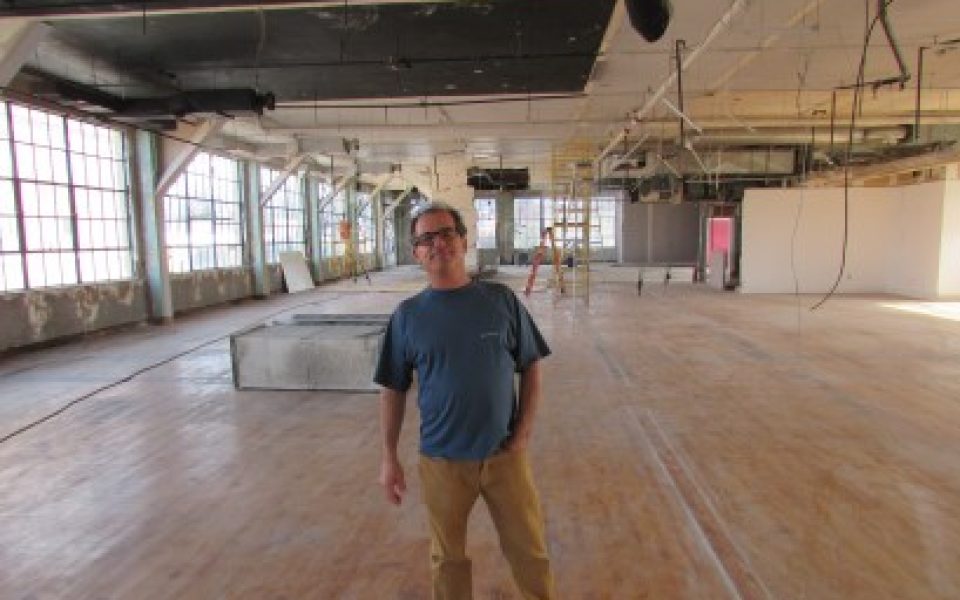Developer Andy Zimmerman is remaking the historic Gateway Center into a landmark of downtown Greensboro’s revitalization, but the investment jeopardizes artists who have up to now thrived in the affordable space.
Jay Jones, a mobile maker whose wares are for sale at the National Gallery in Washington, DC and the Guggenheim in New York City, showed developer Andy Zimmerman a new piece he’s working on for the American Institute of Architects that’s inspired by the iconic 1932 photograph “Lunch Atop a Skyscraper.”
Jones grabbed a small plastic figurine of an oblivious looking businessman carrying a briefcase and placed it at the end of an I-beam with one foot poised perilously over the precipice.
“I love it!” Zimmerman enthused.
The industrious and whimsical quality of the event referenced in the piece likely resonates with both Zimmerman, who is undertaking a complete renovation of his new property, the Old Greensborough Gateway Center at the corner of South Elm Street and Gate City Boulevard.
Zimmerman’s recent purchase in the three-story structure, built in 1919 to house the Hudson Overall Co. (which later became Blue Bell and is the namesake for Hudson’s Hill), portends a makeover of an iconic property at a key location in downtown Greensboro. When the renovations are complete, Zimmerman expects to have invested $4 million in the project, not counting he $3.8 million purchase price.
But it’s likely to undercut an incubator quality that provided generations of creative entrepreneurs like Jones the opportunity to start businesses.
“This gave me an opportunity at an affordable price to get started,” said Jones, who has been a tenant at the Gateway Center for about four years, after launching his business from his garage. “The fact that it’s downtown has been fantastic.”
Jones said he will eventually need a larger space with higher ceilings to do the kind of prototypes and samples that will allow him to bid on bigger projects, but he’s been completely happy with his new landlord since Zimmerman purchased the building in November.
“He’s not going anywhere if he doesn’t want to,” Zimmerman said. “We’re not asking him to leave.”
Zimmerman has already moved tenants out of the west portion of the original building, which runs the length of Bain Street. The warren of hallways and offices has been removed to create the open feel desired by the kind of high-end tenants that Zimmerman is trying to attract. Cinderblock that previously filled the windows to reduce heating costs is being systematically torn out to restore an airy feel.
Zimmerman said he’s in talks with a tenant who wants to put a small general store on the first floor fronting onto South Elm Street to provide everything from cigarettes to salad and soup prepared off-site.
He’s especially proud of the third floor. With a 1936 ceiling removed, the original iron trusses and heart-pine decking are exposed with a 22-foot span from floor to ceiling. With the windows reopened, the floor provides a panoramic view of the city, including the Lincoln Financial Building to the north and the old Daily Flour Mill to the south. A loading dock previously used to take in cotton bales from Bain Street will be repurposed as a cantilevered balcony. Like HQ Greensboro, the nearby building that Zimmerman repurposed into a co-working space, he envisions the new and improved Gateway Center as “less industrial, more creative class,” with lots of exposed brick and period-style fine woodwork framing doorways and windows.
Beyond the aesthetic improvements, the building needs significant investment just to avoid obsolescence, including replacing the HVAC system and repairing the roof, Zimmerman said. He acknowledged that rents will have to increase to cover the cost of the investment.
“It will be their choice of whether they want to stay,” Zimmerman said. “It will be: ‘Here’s the space, here’s what it costs.’”
The Gateway Center provided Benjy Johnson, a musician and recording engineer, with a long runway to incubate his business, Earthtones Recording Studio.
“The Gateway Center has been the only way that I could take 15 years to grow my business,” Johnson said. “I’m old school. The cost of the Gateway Center has afforded me the time to slowly build my business. My hope is that the future works out to where I can stay at the Gateway Center.”
Ed Cone, a writer and occasional blogger, maintained an office at the Gateway Center for 20 years, until late 2013 when he started working out of his home. He said he has pleasant memories of watching downtown Greensboro transform, bringing his dog to work and feeling like a part of the neighborhood. Like other former and current tenants, Cone said he valued the racial and economic diversity in the building. Among his neighbors were a modeling agency “that had young women in bikinis prowling the halls” and the novelist John Hart, who won the Edgar award for mystery writing and the North Carolina Award for Literature.

©
For some tenants, the transfer of ownership and new investment at Gateway Center coincides with their own growing pains. Home State Apparel, whose North Carolina “home” shirt has become a local icon and the foundation for a national concept, is in the final stages of a moving out. Zeke Vantreese, the company’s owner, closed on a 9,660-square foot warehouse south of Interstate 40 off South Elm-Eugene Street in December.
The tenants most impacted by the impending cost increase at the Gateway Center are likely studio artists.
Carmen Neely moved into the Gateway Center in early December, after Zimmerman purchased the building, splitting the $500 monthly rent on an 830-square foot space with a partner.
After receiving her master of fine arts from UNCG in May 2016, Neely considered moving back to Charlotte, where her parents are from, but ultimately decided to put down roots in Greensboro, where she’s found work as an adjunct instructor at NC A&T University.
“I figured it would be easy to find a space,” Neely said. “I didn’t realize it would be so hard. Maybe I should have done more research.” The 205 Collaborative, an artist collective on Lyndon Street on the eastern flank of downtown, was at capacity.
“It took me six months to find [the Gateway Center] and I had to look really diligently,” Neely said.
When she moved into the Gateway Center, Neely said she was immediately struck by how many artists she met and how uncertain their future appeared to be.
“I was shocked by how many people seemed to be anxious,” Neely said. “And this hidden community could be lost, and nobody seems to know what will happen.”
Tristin Miller, an artist who operates the Hand to Hand Market, said the Gateway Center has not only been affordable, but also a community when she rented studio space there. She collaborated with Church World Services, another tenant, as an events coordinator for Mosaic Festival one year and also worked with the nonprofit’s refugee clients to produce handmade goods. She periodically visited equestrian artist Jan Lukens, whom she considers a mentor, to consult him for business advice.
As an indicator of how affordable her studio was, Miller said she paid $250 a month and would have spent $150 at 205 Collaborative for half or even a quarter of the space. Although she was aware of Zimmerman’s plans to buy the building, Miller said she left in 2015 for a different reason: Because of a personal injury and financial challenges the year before she found herself unable to catch up on rent even though the previous building management made every effort to work with her. If she hadn’t encountered those challenges, however, Miller believes she would ultimately have been forced to leave due to the transfer of ownership and new investment.
Zimmerman said he would like to reserve some space in the Gateway Center for artists after the renovations but he’s not sure how it will work out. He added that he’s looking for a downtown property that could potentially absorb some of the artists who will be priced out of the new Gateway Center.
“I think we need an artist makerspace,” Zimmerman said. “It needs to be in downtown Greensboro. It needs to be affordable to give artists the time they need to get going. Not to be there forever.”
Miller said given its proximity, she wouldn’t be surprised if Glenwood emerges as the neighborhood where artists go for affordable studio space.
Miller said she told Neely: “You know, Carmen, I don’t think there will ever be a successful artist space unless the artists do it.”
While crediting Zimmerman for the positive effect of his investments in downtown — she was able to hold a pop-up market at Gibb’s Hundred Brewing Co., another property he redeveloped — Miller said she believes artists ultimately will need to take shared responsibility for ensuring they have studio space instead of relying on developers. She ended up selling her furniture to make art in her apartment living room, and doesn’t think she’s up for the task of coordinating an artist space herself. That task may fall to an up-and-comer like Neely.
“With [the National Endowment for the Arts] funding being completely wiped out, if we’re looking at this bleak future for arts funding,” Neely said, “we need to talk as a community about coming together and supporting artists and creators.”
Join the First Amendment Society, a membership that goes directly to funding TCB‘s newsroom.
We believe that reporting can save the world.
The TCB First Amendment Society recognizes the vital role of a free, unfettered press with a bundling of local experiences designed to build community, and unique engagements with our newsroom that will help you understand, and shape, local journalism’s critical role in uplifting the people in our cities.
All revenue goes directly into the newsroom as reporters’ salaries and freelance commissions.





Leave a Reply